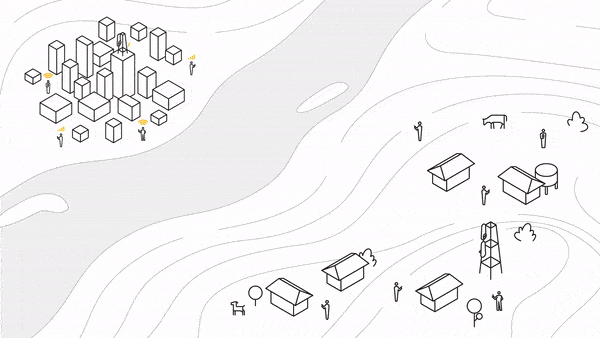While we tackle scores of digital tasks daily on our desktop computers, smartphones, smart watches, notebooks, security devices and sound systems, and converse with Siri, Alexa and Google Assistant to answer questions or execute everyday tasks, we sometimes forget how lucky we are.
Some 4 billion people globally have no Internet. If they want to turn on a light or listen to a playlist of songs, they must actually get up and flip a switch or select a CD or record and place it in a player. That, of course, assumes they can afford such luxuries.
Google’s Alphabet X innovation lab announced this week that it is developing technology to deliver high-speed internet access to regions in Africa that have been left behind in the digital revolution. The enterprise, called Project Taara, will employ invisible light beams connected to tall towers to bring low-cost Internet access to sub-Sharan Africa, beginning with Kenya.
Using beams of light allows connectivity within regions that are geographically hostile to traditional fiber cables. In other regions, protected nature zones or communities affected by conflict or war have made construction of traditional cable lines impossible.
The Taara group says a single 20 Gbps link can carry signals up to 12 miles and provide ample connectivity for thousands of residents to view videos simultaneously. As some observers have noted, it is basically a fiber optic network cable without the physical cable.
According to blog posted Monday, Project Taara General Manager Mahesh Krishnaswamy said: “By creating a series of links from our partner’s fiber optic network over ground to underserved areas, Taara’s links can relay high speed, high quality internet to people without the time, cost and hassle involved in digging trenches or stringing cables along poles.”
To ensure continuous connectivity, Taara’s links are placed atop tall towers or rooftops. It not only provides security for the towers but also helps ensure the networks retain unbroken lines of sight.
Alphabet is working with the Econet Group and Liquid Telecom to bring service to communities that, digitally, have remained in the 1980s.
Project Taara is an offshoot of an earlier undertaking, Project Loon. In 2013, Google X launched 30 high-altitude balloons (hence, the name “Loon”) up to 16 miles into the stratosphere to establish a wireless network unencumbered by physical obstacles on land. The objective then, too, was to bring Internet service—in this instance, up to 1Mbps speeds—to underserved regions in remote and poor areas, as well as to regions affected by natural disasters.
Krishnaswamy said in his blog post, “Connectivity is more important than ever. The pandemic sparked a dramatic shift in how we work, learn and stay in touch with family and friends, and underscored just how important fast and affordable internet is to our daily lives.”
“Studies show that meaningful connectivity is essential for economic growth and to fast track access to opportunity,” he stated, noting that “many people still can’t afford a connection that is fast enough to join a video call, let alone attend school or work remotely.”
Krishnaswamy says he hopes the project will spread throughout Africa and other poor and remote communities. He invited other internet service providers and mobile network operators to join the project.
Google’s parent sends Internet balloons to reconnect Puerto Rico cell phones
More information:
blog.x.company/bringing-light- … -africa-4e022e1154ca
2020 Science X Network
Citation:
Alphabet harnesses light beams to bring Internet to Africa (2020, November 11)
retrieved 11 November 2020
from https://techxplore.com/news/2020-11-alphabet-harnesses-internet-africa.html
This document is subject to copyright. Apart from any fair dealing for the purpose of private study or research, no
part may be reproduced without the written permission. The content is provided for information purposes only.


